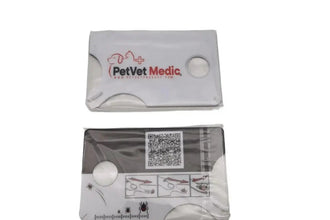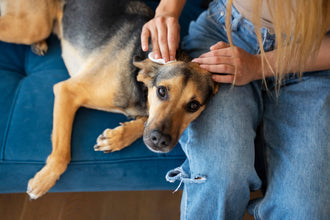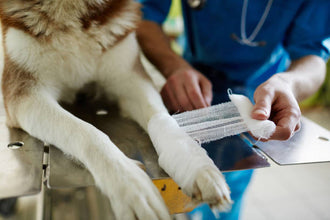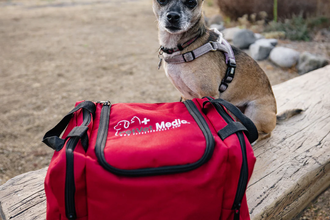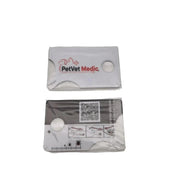
Ticks may be tiny, but they can cause serious health problems for your dog. Outdoor-loving dogs, especially those who run through tall grass, wooded areas, or brush, are at a higher risk of tick bites. Left untreated, a tick can feed on your dog for several days, transmitting harmful bacteria and potentially leading to life-threatening illnesses.
If you’re a pet parent who enjoys outdoor adventures with your dog, learning how to remove ticks correctly — and prevent infections — is essential. This guide will show you how to do it safely using the PetVet Medic Card, part of our pet first aid supplies at petvetproduct.com.
We’ll also cover the dangers ticks pose, common mistakes to avoid, post-removal care, and long-term prevention strategies so you can protect your dog year-round.
Why Tick Removal Matters
Ticks aren’t just unpleasant to look at — they are efficient disease carriers. These parasites latch onto your dog’s skin, feed on blood, and can stay attached for days. During feeding, they can transmit pathogens that cause illnesses in dogs and even humans.
Common Tick-Borne Diseases in Dogs
-
Lyme Disease – Caused by Borrelia burgdorferi, leading to lameness, joint swelling, fever, and lethargy.
-
Anaplasmosis – Symptoms include loss of appetite, stiff joints, and neurological signs.
-
Ehrlichiosis – Can cause fever, nosebleeds, anemia, and chronic fatigue.
-
Babesiosis – Attacks red blood cells, causing weakness and jaundice.
Some of these diseases have long-term health effects and require ongoing treatment. Early tick removal is your best defense.
Why Choose the PetVet Medic Card for Tick Removal
When it comes to ticks, the right removal tool matters. The PetVet Medic Card, available from petvetproduct.com, is designed specifically for safe, complete tick removal.
Benefits of the PetVet Medic Card
-
Precision Removal – Special notches fit securely under ticks without squeezing their bodies.
-
Prevents Pathogen Release – Avoids crushing ticks, which can inject bacteria into the wound.
-
Portable and Compact – Credit card-sized, perfect for wallets or hiking packs.
-
Multi-functional – Works for removing ticks, splinters, and small embedded debris.
-
Reusable and Easy to Clean – Wash and disinfect for repeated use.
Compared to makeshift tools like regular tweezers, which can leave tick mouthparts embedded, the Medic Card is safer and more effective.
Preparing for Safe Tick Removal
Tick removal isn’t something you want to improvise. Preparation ensures a smoother, stress-free process for you and your dog.
Essential Items from Your Pet First Aid Supplies
From your pet vet first aid supplies, you’ll need:
-
PetVet Medic Card
-
Disposable gloves
-
Pet-safe antiseptic wipes or spray
-
Saline solution (optional for cleaning before/after)
-
Cotton balls or sterile gauze pads
-
Small sealable bag or container (for the tick)
-
Treats to calm and reward your dog afterward
Having these ready avoids delays and keeps your dog calm throughout the process.
Step-by-Step Guide: Using the PetVet Medic Card
Follow these steps carefully for safe and complete tick removal:
Step 1 – Secure Your Dog Comfortably
-
Choose a quiet, well-lit area.
-
Ask a helper to gently hold your dog still.
-
If your dog is anxious or tries to bite when handled, consider a soft muzzle for safety.
Step 2 – Identify the Tick
-
Part the fur to expose the skin.
-
Look for a small, round body attached to the skin — colors range from light brown to dark gray, depending on how engorged the tick is.
Step 3 – Position the Card
-
Choose the notch on the PetVet Medic Card that best fits around the tick’s body.
-
Slide the notch gently between the tick and your dog’s skin, keeping the card flat.
Step 4 – Lift and Slide Out
-
Slowly slide the card forward, gently lifting as you go.
-
The tick should detach intact, including the head and mouthparts.
Step 5 – Dispose of the Tick
-
Place the tick in a sealable bag or container.
-
You can store it for identification if your vet needs to test for tick-borne diseases.
Step 6 – Clean the Bite Area
-
Use pet-safe antiseptic wipes to disinfect the wound.
-
Pat dry with sterile gauze.
Step 7 – Clean Your Tools
-
Wash the PetVet Medic Card with warm soapy water.
-
Rinse and dry before returning it to your pet emergency care supplies kit.
Post-Removal Care to Prevent Infections
Removing the tick is only the first step. The bite site is still vulnerable to irritation or infection.
Monitor the Bite Area
Check daily for:
-
Redness that spreads
-
Swelling or heat
-
Pus or unusual discharge
-
Persistent itching or discomfort
If symptoms worsen after 48 hours, contact your vet — bacterial infections can develop quickly.
Watch for Systemic Symptoms
Tick-borne illnesses sometimes take days or weeks to appear. Warning signs include:
-
Fever
-
Loss of appetite
-
Joint stiffness or limping
-
Lethargy or unusual fatigue
Prompt veterinary care increases the chances of full recovery.
Common Mistakes to Avoid During Tick Removal
Many pet owners unintentionally make mistakes that increase infection risk or disease transmission. Avoid these pitfalls:
-
Twisting the tick – Can break off mouthparts.
-
Using bare hands – Risk of transmitting tick-borne pathogens to humans.
-
Burning or applying substances – Using matches, oils, or chemicals can stress the tick, causing it to release more bacteria into the wound.
-
Pulling too quickly – Rushing removal can leave parts embedded.
Preventing Future Tick Problems
Tick prevention is as important as removal. Here’s how to keep ticks away from your dog:
Daily Tick Checks
-
Run your hands over your dog’s body after outdoor activities.
-
Pay attention to ears, neck, underarms, groin, and between toes.
Grooming and Maintenance
-
Brush your dog regularly to spot ticks early.
-
Keep fur around ears and paws trimmed for easier inspections.
Yard and Outdoor Management
-
Mow grass regularly and keep bushes trimmed.
-
Remove piles of leaves and debris where ticks thrive.
-
Consider creating gravel or woodchip barriers between wooded areas and your lawn.
Preventative Treatments
Speak to your veterinarian about tick preventatives such as:
-
Monthly topical treatments
-
Oral chewables
-
Tick collars
Combining these strategies greatly reduces the risk of tick infestations.
Why Pet Emergency Care Supplies Are a Must for Outdoor Dogs
Ticks aren’t the only hazard for adventurous dogs. A well-stocked pet vet first aid supplies kit can help you handle cuts, scrapes, insect stings, and other minor emergencies on the spot.
Essentials for Outdoor Pet Safety
-
PetVet Medic Card – For tick and splinter removal.
-
Styptic powder – Stops minor bleeding quickly.
-
Saline solution – Cleans wounds and eyes.
-
Vet wrap and gauze – Protects wounds from dirt and licking.
-
Digital thermometer – Detects fever, a sign of infection.
-
Emergency contact numbers – For your vet and nearest 24-hour clinic.
At petvetproduct.com, our complete kits ensure you’re prepared no matter where your adventures take you.
Conclusion
Ticks are a serious health threat, but with preparation and the right tools, you can protect your dog effectively. The PetVet Medic Card, part of our pet first aid supplies at petvetproduct.com, allows you to remove ticks quickly, safely, and completely — reducing the risk of infection and disease.
By following the correct removal technique, practicing good post-removal care, and adopting strong prevention habits, you’ll give your dog the best defense against these dangerous parasites. Keep your pet vet first aid supplies stocked, carry your PetVet Medic Card on every outing, and enjoy your outdoor adventures worry-free.
FAQs About Tick Removal and First Aid
While regular tweezers can work, they increase the risk of crushing the tick and leaving mouthparts embedded. The PetVet Medic Card is designed to remove ticks cleanly and safely.
Do not dig at the skin. Clean the area, keep it protected, and see your vet for safe removal.
Yes, place it in a sealed bag. Your vet may want to test it if your dog develops symptoms.
Absolutely. The notches come in different sizes to suit small and large dogs alike.
Daily checks are ideal, especially during peak tick season (spring to fall).






